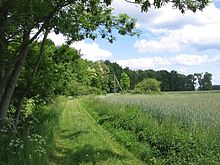Woodland edge

A woodland edge or forest edge is the transition zone (ecotone) from an area of woodland or forest to fields or other open spaces. Certain species of plants and animals are adapted to the forest edge, and these species are often more familiar to humans than species only found deeper within forests. A classic example of a forest edge species is the white-tailed deer in North America.[citation needed]
The woodland edge on maps
On
cartographers prefer to show even small islands of trees, while others – depending on the scale of the map – prefer more general
, continuous lines to demarcate the forest or woodland edges.
For specialised work, aerial photographs or
cultural boundaries
are not legally binding.
Woodland edges and biology
succession
of an abandoned meadowOn the woodland edge – however it is defined – not only does the
brambles
and low-growing plants.
The more gradual the transition from open country to woodland (for example, through intermediate young trees or bushes), the less risk there is that, in stormy weather, wind will blow under the canopy and uproot the outer rows of trees. The structure of the woodland edge and its maintenance is viewed as important in forest management especially during reforestation.
Hunters also use the forest edge for the observation and hunting of wildlife, for example, by using tree stands or hides
.
See also
Literature
- Thomas Coch, Hermann Hondong: Waldrandpflege. Grundlagen und Konzepte. 21 Tabellen. "Praktischer Naturschutz" series. Neumann, Radebeul, 1995, ISBN 3-7402-0150-9
- Beinlich, B., Gockel, H. A. & Grawe, F. (2014): Mittelwaldähnliche Waldrandgestaltung – Ökonomie und Ökologie im Einklang. – ANLiegen Natur 36(1): 61–65, Laufen. PDF 0.7 MB.
External links
Look up woodland edge in Wiktionary, the free dictionary.
